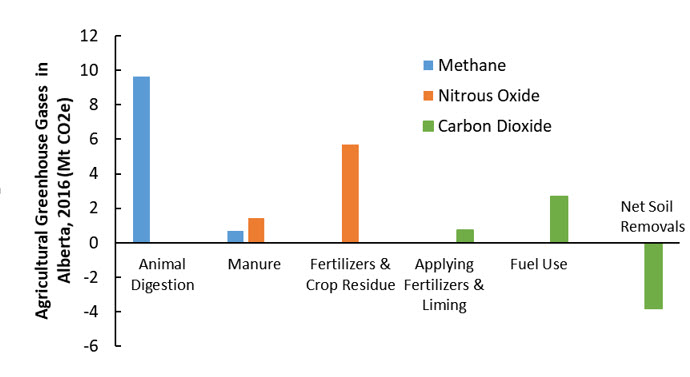







| This section provides some background on what’s driving interest in this topic, where agricultural emissions come from, and agriculture’s share of global, national and provincial emissions.
Background
Climate change is the long-term shift in weather patterns - such as temperature, precipitation, and timing of events. Climates can change gradually over wide areas, or rapidly with high intensity in specific locations.
Greenhouse gases in the atmosphere act as a thermostat that controls the earth's climate. Increasing levels of greenhouse gases in the atmosphere have been linked to:
More variable temperatures, with trends towards more warmth
More variable rainfall, with trends towards lower amounts
Extreme weather events that occur more often
These changes are influenced by human actions, including many industrial activities and the release of natural carbon sinks by cultivation and deforestation.
More information about past trends, present conditions and possible future climate scenarios and principles of management strategies are discussed in the Building Climate Resilience section.
Where Do Agricultural Emissions Come From?
The three types of greenhouse gases in agricultural systems are methane (CH4), nitrous oxide (N20) and carbon dioxide (CO2). Source: Environment Canada, 2010.
Agricultural operations influence three types of greenhouse gases over a wide range of production practices:
Methane (CH4) from decomposing plant and animal materials mostly in conditions without oxygen. Some sources are stomachs of ruminants, liquid manure storages or shallow waterbodies.
Nitrous oxide (N2O) emissions occur when sources of nitrogen are processed by living organisms mostly where oxygen is limited. Some sources are fertilizers under wet conditions, liquid and stockpiled manures, decomposing crop residue and cultivated soils.
Carbon dioxide (CO2) from fossil fuel use and from decaying organisms. Some sources are on-farm fuel and energy use, soils after cultivation, summer fallow, or land use change from perennial to annual crops. Agricultural management can also act as a carbon dioxide "sink". After growing plants have removed carbon dioxide from the atmosphere, increased carbon can be stored in soils by conservation tillage, continuous cropping, growing perennials after annual crops, and by planting trees or windbreaks.
.
Carbon dioxide equivalent (CO2e) units are used to compare the effects of different greenhouse gases on global warming. Compared with carbon dioxide, methane has 25 times more global warming potential and nitrous oxide has 298 times more global warming potential.
What’s Agriculture’s Share ?
Agricultural greenhouse emissions are small on an area or an animal basis, but accumulate over large areas and large numbers of livestock. Agricultural emissions in 2016 were:
8.5% of Canada's emissions from all sources
31% of Canada's agricultural emissions
6.9% of Alberta's total emissions (22 Mt of CO2e)
Alberta’s greenhouse gas emissions by sector in 2014 as a percent of provincial totals. Source: Climate Leadership Plan, 2015.
In 2016, about half of Alberta's agricultural emissions were from the livestock sector and about half were from the cropping sector. Emissions from on-farm fuel use were 15% of Alberta's agricultural emissions. Increases in soil carbon storage due to conservation cropping and land use change also removed about 18% of Alberta's agricultural emissions.

Alberta’s agricultural greenhouse gas emissions and removals in 2016. Data supplied by Environment Canada.
Trends Indicate That:
.
Methane emissions from animal production in Alberta have decreased since 2005, due to efficiency improvements and to lower cattle numbers.
Higher yielding crops that use more fertilizer and manure have increased emissions of nitrous oxide.
More land area in annual crops has increased carbon dioxide emissions from fuel use.
Rates of soil carbon removal are decreasing as conservation cropping and reduced tillage become more widely practiced and areas of perennial crops decline.
For more information about trends, see: Agriculture and Agri-Food Canada's Agricultural Greenhouse Gas Indicator |